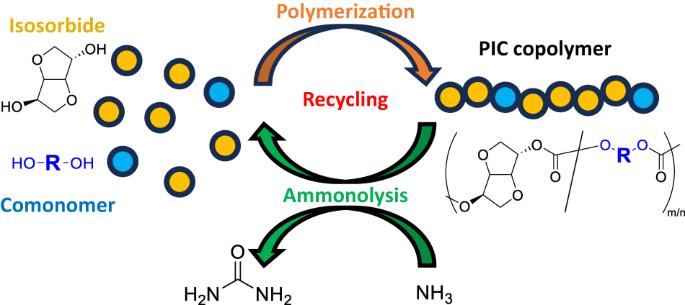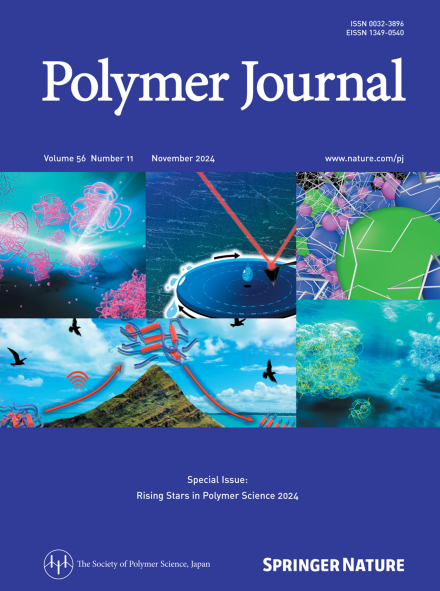聚(碳酸异山梨酯)共聚物的特性和氨解行为
IF 2.7
4区 化学
Q3 POLYMER SCIENCE
引用次数: 0
摘要
为实现可持续社会的发展,可回收聚合物的开发备受关注。聚碳酸酯(PC)是一种具有高热稳定性和高透明度的工程塑料。我们重点研究了聚(碳酸异山梨酯)(PIC),这是一种生物基 PC,由从葡萄糖中提取的异山梨醇(ISB)合成。PIC 具有出色的透明度、热性能和物理性能,有望成为传统 PC 的替代品。本研究制备了 PIC 与几种二元醇共聚物的共聚物,以明确共聚对 PIC 共聚物与氨发生分解反应(即氨解将 PIC 共聚物转化为单体和尿素)的影响。此外,还对所得共聚物的热性能和物理性能进行了研究。共聚后,PIC 共聚物的热稳定性保持稳定,玻璃化转变温度主要受引入的共聚单体结构柔性的影响。用 1,4 丁二醇合成的共聚物的机械性能发生了急剧变化,这为用较小的共聚单体比例增韧 PIC 提供了指导。最后,我们研究了用氨水处理共聚物的分解行为。PIC 共聚物被分解成 ISB、共聚单体和尿素,氨分解率受引入结构的影响。这项研究通过氨解促进了 ISB 作为生物质资源的有效利用,是聚碳酸酯的一种有效化学回收工艺。本文章由计算机程序翻译,如有差异,请以英文原文为准。


Characterization and ammonolysis behavior of poly(isosorbide carbonate)-based copolymers
The development of recyclable polymers has attracted considerable attention for realizing the development of a sustainable society. Polycarbonates (PCs) are engineering plastics with high thermal stability and transparency. We focused on poly(isosorbide carbonate) (PIC), a bio-based PC synthesized from isosorbide (ISB) derived from glucose. PIC is expected to function as an alternative to conventional PCs because of its outstanding transparency and thermal and physical properties. This study prepared PIC copolymers with several types of diol comonomers to clarify the effect of copolymerization on the decomposition reaction with ammonia, i.e., ammonolysis for converting PIC copolymers into monomers and urea. The thermal and physical properties of the resulting copolymers were also investigated. The thermal stability of the PIC copolymers remained stable after copolymerization, and the glass transition temperature was affected mainly by the flexibility of the structure of the introduced comonomer. A drastic change in mechanical properties was observed for the copolymer synthesized with 1,4-butanediol, which provides guidelines for toughening PIC with a small comonomer ratio. Finally, we investigated the decomposition behavior of the copolymers by treatment with aqueous ammonia. The PIC copolymers were decomposed into ISB, comonomers, and urea, and the ammonolysis rate was affected by the introduced structure. This study promotes the effective use of ISB as a biomass resource through ammonolysis, which is an effective chemical recycling process for polycarbonate. To functionalize a poly(isosorbide carbonate) (PIC)-based polymer and evaluate its recyclability, several types of diol comonomers were copolymerized with isosorbide. The thermal and mechanical properties and decomposition behavior of the PIC copolymers were investigated. The thermal stability of PIC was retained, and its glass transition temperature was systematically controlled by copolymerization. The decomposition of the PIC copolymers upon treatment with aqueous ammonia yielded monomers and urea, and the decomposition rate was governed by the structure of the comonomer.
求助全文
通过发布文献求助,成功后即可免费获取论文全文。
去求助
来源期刊

Polymer Journal
化学-高分子科学
CiteScore
5.60
自引率
7.10%
发文量
131
审稿时长
2.5 months
期刊介绍:
Polymer Journal promotes research from all aspects of polymer science from anywhere in the world and aims to provide an integrated platform for scientific communication that assists the advancement of polymer science and related fields. The journal publishes Original Articles, Notes, Short Communications and Reviews.
Subject areas and topics of particular interest within the journal''s scope include, but are not limited to, those listed below:
Polymer synthesis and reactions
Polymer structures
Physical properties of polymers
Polymer surface and interfaces
Functional polymers
Supramolecular polymers
Self-assembled materials
Biopolymers and bio-related polymer materials
Polymer engineering.
 求助内容:
求助内容: 应助结果提醒方式:
应助结果提醒方式:


